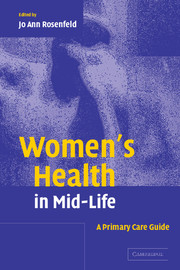Book contents
- Frontmatter
- Contents
- List of contributors
- 1 Introduction
- Part I Health promotion
- Part II Hormonal changes
- Part III Disease prevention
- 12 Prevention of coronary heart disease in women
- 13 Hypertension and stroke
- 14 Diagnosis and treatment of osteoporosis
- 15 Diabetes in mid-life women
- Part IV Cancer prevention
- Index
- References
12 - Prevention of coronary heart disease in women
from Part III - Disease prevention
Published online by Cambridge University Press: 21 August 2009
- Frontmatter
- Contents
- List of contributors
- 1 Introduction
- Part I Health promotion
- Part II Hormonal changes
- Part III Disease prevention
- 12 Prevention of coronary heart disease in women
- 13 Hypertension and stroke
- 14 Diagnosis and treatment of osteoporosis
- 15 Diabetes in mid-life women
- Part IV Cancer prevention
- Index
- References
Summary
Case 1: a 62-year-old woman comes to you as a new patient. She has no complaints but needs preventive care. She smokes one pack of cigarettes per day and is on no medications. She does no regular physical exercise and has a desk job. She has no chronic medical problems. Her blood pressure is 150/90mmHg, and she has a body mass index (BMI) of 38kg/m2 and a waist-to-hip ratio of 1.2. There are no other physical exam abnormalities. You order fasting screening labs, which show total cholesterol of 265mg/dl (6.9 mmol/l), low-density lipoprotein (LDL) 180mg/dl (4.7mmol/l), high-density lipoprotein (HDL) 25mg/dl (0.65mmol/l), triglycerides 300mg/dl (3.4mmol/l), and glucose 180mg/dl.
Case 2: a 65-year-old woman presents for new patient evaluation after a recent hospitalization for an inferior myocardial infarction (MI). She was treated acutely with angioplasty and stent placement in the right coronary artery. She also has a 30% left anterior descending coronary artery lesion and a 20% circumflex lesion. Her ejection fraction is 40%. She has had no further angina and denies symptoms of congestive heart failure. She smokes half a pack of cigarettes per day and proudly tells you this is much less than she used to smoke. She has no other chronic medical problems.
She is taking atenolol, aspirin, and atorvastatin. Her blood pressure is 160/100mmHg, pulse is 90bpm, BMI is 35kg/m2, and the reminder of her examination is unremarkable. In hospital, her cholesterol was 330mg/dl (8.5mmol/l), LDL 190mg/dl (4.9mmol/l), HDL 40 mg/dl (1.0mmol/l), triglycerides 500mg/dl (5.6mmol/l), and hemoglobin A1C 6.0%.[…]
Keywords
- Type
- Chapter
- Information
- Women's Health in Mid-LifeA Primary Care Guide, pp. 209 - 224Publisher: Cambridge University PressPrint publication year: 2004
References
- 1
- Cited by

